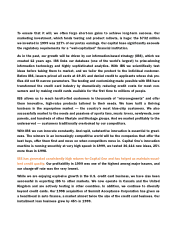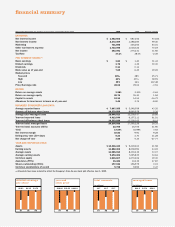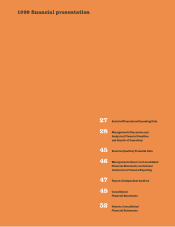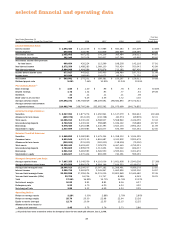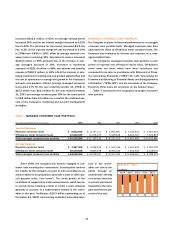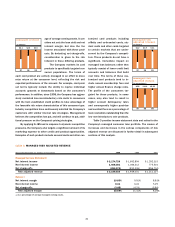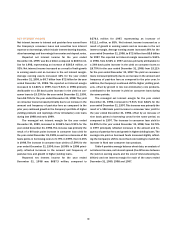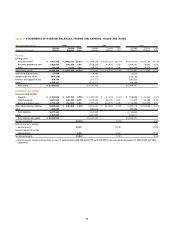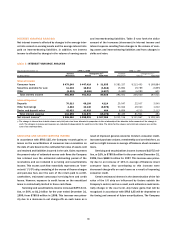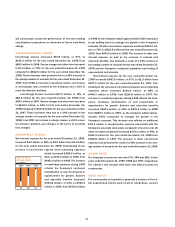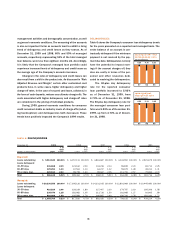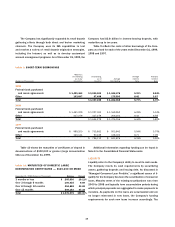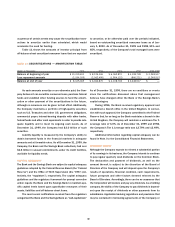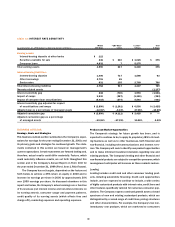Capital One 1999 Annual Report Download - page 33
Download and view the complete annual report
Please find page 33 of the 1999 Capital One annual report below. You can navigate through the pages in the report by either clicking on the pages listed below, or by using the keyword search tool below to find specific information within the annual report.
32
NET INTEREST INCOME
Net interest income is interest and past-due fees earned from
the Company’s consumer loans and securities less interest
expense on borrowings, which include interest-bearing deposits,
other borrowings and borrowings from senior and deposit notes.
Reported net interest income for the year ended
December 31, 1999, was $1.1 billion compared to $687.3 mil-
lion for 1998, representing an increase of $365.4 million, or
53%. Net interest income increased as a result of both growth
in earning assets and an increase in the net interest margin.
Average earning assets increased 34% for the year ended
December 31, 1999, to $9.7 billion from $7.2 billion for the year
ended December 31, 1998. The reported net interest margin
increased to 10.86% in 1999, from 9.51% in 1998 primarily
attributable to a 58 basis point increase in the yield on con-
sumer loans to 19.33% for the year ended December 31, 1999,
from 18.75% for the year ended December 31, 1998. The yield
on consumer loans increased primarily due to an increase in the
amount and frequency of past-due fees as compared to the
prior year, continued growth in the Company’s portfolio of higher
yielding products and repricings of low introductory rate loans
during late 1998 and early 1999.
The managed net interest margin for the year ended
December 31, 1999, increased to 10.83% from 9.91% for the
year ended December 31, 1998. This increase was primarily the
result of a 60 basis point increase in consumer loan yield for
the year ended December 31, 1999, as well as a decrease of 26
basis points in borrowing costs to 5.79% in 1999, from 6.05%
in 1998. The increase in consumer loan yield to 17.59% for the
year ended December 31, 1999, from 16.99% in 1998 princi-
pally reflected increases in the amount and frequency of
past-due fees and growth in higher yielding loans.
Reported net interest income for the year ended
December 31, 1998 was $687.3 million, compared to
$376.1 million for 1997, representing an increase of
$311.1 million, or 83%. Net interest income increased as a
result of growth in earning assets and an increase in the net
interest margin. Average earning assets increased 26% for the
year ended December 31, 1998, to $7.2 billion from $5.8 billion
for 1997. The reported net interest margin increased to 9.51%
in 1998, from 6.54% in 1997 and was primarily attributable to
a 364 basis point increase in the yield on consumer loans to
18.75% for the year ended December 31, 1998, from 15.11%
for the year ended December 31, 1997. The yield on consumer
loans increased primarily due to an increase in the amount and
frequency of past-due fees as compared to the prior year. In
addition, the Company’s continued shift to higher yielding prod-
ucts, offset by growth in low non-introductory rate products,
contributed to the increase in yield on consumer loans during
the same periods.
The managed net interest margin for the year ended
December 31, 1998, increased to 9.91% from 8.81% for the
year ended December 31, 1997. This increase was primarily the
result of a 126 basis point increase in consumer loan yield for
the year ended December 31, 1998, offset by an increase of
nine basis points in borrowing costs for the same period, as
compared to 1997. The increase in consumer loan yield to
16.99% for the year ended December 31, 1998, from 15.73%
in 1997 principally reflected increases in the amount and fre-
quency of past-due fees and growth in higher yielding loans. The
average rate paid on borrowed funds increased slightly reflect-
ing the Company’s shift to more fixed rate funding to match the
increase in fixed rate consumer loan products.
Table 4 provides average balance sheet data, an analysis of
net interest income, net interest spread (the difference between
the yield on earning assets and the cost of interest-bearing lia-
bilities) and net interest margin for each of the years ended
December 31, 1999, 1998 and 1997.


